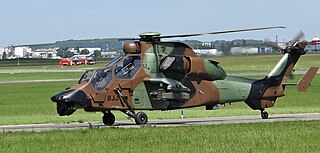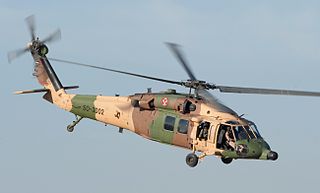
The Bell OH-58 Kiowa is a family of single-engine single-rotor military helicopters used for observation, utility, and direct fire support. It was produced by the American manufacturer Bell Helicopter and is closely related to the Model 206A JetRanger civilian helicopter.

The Eurocopter Tiger is a four-blade, twin-engine attack helicopter which first entered service in 2003. It is manufactured by Airbus Helicopters, which arose from the merger of Aérospatiale's and DASA's respective helicopter divisions. Airbus Helicopters designates it as the EC665. In France and Spain, the Tiger is known as the Tigre, while in Germany it is referred to as the Tiger.

The Boeing–Sikorsky RAH-66 Comanche is an American stealth armed reconnaissance and attack helicopter designed for the United States Army. Following decades of study and development, the RAH-66 program was canceled in 2004 before mass production began, by which point nearly US$7 billion had been spent on the program.

Bell Textron Inc. is an American aerospace manufacturer headquartered in Fort Worth, Texas. A subsidiary of Textron, Bell manufactures military rotorcraft at facilities in Fort Worth, and Amarillo, Texas, USA as well as commercial helicopters in Mirabel, Quebec, Canada.

The LHTEC T800 is a turboshaft engine for rotary wing applications. It is produced by the LHTEC, a joint venture between Rolls-Royce and Honeywell. The commercial and export version is the CTS800. The engine was primarily developed for the United States Army's cancelled RAH-66 Comanche armed reconnaissance helicopter, but has found use in other applications.

The Piasecki X-49 "SpeedHawk" is an American four-bladed, twin-engined experimental high-speed compound helicopter developed by Piasecki Aircraft. The X-49A is based on the airframe of a Sikorsky YSH-60F Seahawk, but utilizes Piasecki's proprietary vectored thrust ducted propeller (VTDP) design and includes the addition of lifting wings. The concept of the experimental program was to apply the VTDP technology to a production military helicopter to determine any benefit gained through increases in performance or useful load.

The Bell 407 is a four-blade, single-engine, civil utility helicopter. A derivative of the Bell 206L-4 LongRanger, the 407 uses the four-blade, soft-in-plane design rotor with composite hub developed for the United States Army's OH-58D Kiowa Warrior instead of the two-blade, semi-rigid, teetering rotor of the 206L-4.

The Boeing MH-6M Little Bird and its attack variant, the AH-6, are light helicopters used for special operations in the United States Army. Originally based on a modified OH-6A, it was later based on the MD 500E, with a single five-bladed main rotor. The newest version, the MH-6M, is based on the MD 530F and has a single, six-bladed main rotor and four-bladed tail rotor.

The Boeing A160 Hummingbird is an unmanned aerial vehicle (UAV) helicopter. Its design incorporates many new technologies never before used in helicopters, allowing for greater endurance and altitude than any helicopter currently in operation.

The EurocopterUH-72 Lakota is a twin-engine helicopter with a single, four-bladed main rotor. The UH-72 is a militarized version of the Eurocopter EC145, built by American Eurocopter, a division of Airbus Group, Inc. Several hundred UH-72 of various types have entered service by the 2020s since its introduction in 2006.

The Sikorsky X2 is an experimental high-speed compound helicopter with coaxial rotors, developed by Sikorsky Aircraft, that made its first flight in 2008 and was officially retired in 2011.

A military helicopter is a helicopter that is either specifically built or converted for use by military forces. A military helicopter's mission is a function of its design or conversion. The most common use of military helicopters is transport of troops, but transport helicopters can be modified or converted to perform other missions such as combat search and rescue (CSAR), medical evacuation (MEDEVAC), airborne command post, or even armed with weapons for attacking ground targets. Specialized military helicopters are intended to conduct specific missions. Examples of specialized military helicopters are attack helicopters, observation helicopters and anti-submarine warfare (ASW) helicopters.

The Boeing AH-6 is a series of light helicopter gunships based on the MH-6 Little Bird and MD 500 family. Developed by Boeing Rotorcraft Systems, these include the Unmanned Little Bird (ULB) demonstrator, the A/MH-6X Mission Enhanced Little Bird (MELB), and the proposed AH-6I and AH-6S.
The Honeywell HTS900 is an American turboshaft engine produced by Honeywell Aerospace. A growth version of the LTS101 which it is designed to replace, the HTS900 is in the 1,000 shp (745 kW) class.

The Light Helicopter Experimental (LHX) program was a 1980s United States Army helicopter procurement project to replace the AH-1 Cobra and OH-58 Kiowa helicopters. The result of this program lead to the development of the RAH-66 Comanche, which was cancelled before entering production.
The Armed Aerial Scout (AAS) was the planned replacement for the OH-58 Kiowa in United States Army service. This program resulted after the Armed Reconnaissance Helicopter resulted in selection of the Bell ARH-70 Arapaho, but was ultimately not procured due to financial and other reasons, and the AAS program itself did result in a new design procurement. The next program lead to the Future Attack Reconnaissance Aircraft, which was also halted before procurement. Meanwhile the OH-58 was retired by the 2020s, leaving the Army to fill the gap with other types of aircraft and systems.

The Sikorsky S-97 Raider is a high-speed scout and attack compound helicopter based on the Advancing Blade Concept (ABC) with a coaxial rotor system under development by Sikorsky Aircraft. Sikorsky planned to offer it for the United States Army's Armed Aerial Scout program, along with other possible uses. The S-97 made its maiden flight on 22 May 2015.

Future Vertical Lift (FVL) is a plan to develop a family of military helicopters for the United States Armed Forces. Five different sizes of aircraft are to be developed, sharing common hardware such as sensors, avionics, engines, and countermeasures. The U.S. Army has been considering the program since 2004. FVL is meant to develop replacements for the Army's UH-60 Black Hawk, AH-64 Apache, CH-47 Chinook, and OH-58 Kiowa helicopters. The precursor for FVL is the Joint Multi-Role (JMR) helicopter program.

The Sikorsky–Boeing SB-1 Defiant was the Sikorsky Aircraft and Boeing entry for the United States Army's Future Long-Range Assault Aircraft program to replace the Sikorsky UH-60 Black Hawk. It is a compound helicopter with rigid coaxial rotors, powered by two Honeywell T55 turboshaft engines; it first flew on 21 March 2019.
The Future Attack Reconnaissance Aircraft (FARA) program was initiated by the United States Army in 2018 to develop a successor to the Bell OH-58 Kiowa scout helicopter as part of the Future Vertical Lift program. The OH-58 was retired in 2017; three prior programs for a successor were cancelled prior to reaching production: Light Helicopter Experimental, Armed Reconnaissance Helicopter, and Armed Aerial Scout. Several billions of dollars were spent without delivering any new helicopters to service, due to this cycle of development and cancellation. During this time the armed scout role was filled primarily by the Vietnam-era OH-58, which was finally retired in the late 2010s, leaving the Army to use attack helicopters to fill in this role.


















